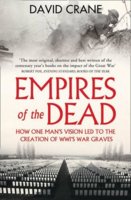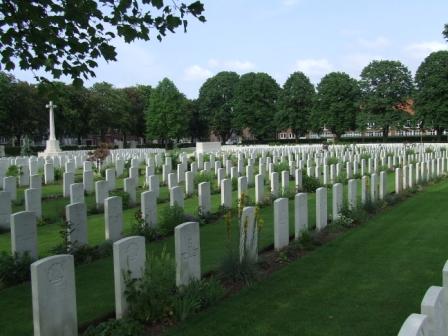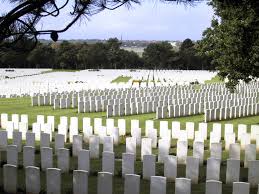This is a study of how one Fabian Ware created the funereal symbols we now associate with World War I and subsequent wars. The subtitle is ‘How one man’s vision led to the creation of WWI’s war graves.’

A reference to ‘war graves’ brings to mind green grass and ranks of white head stones to many of us. A reference to symbols evokes the solemn statuary say in Martin Place, or the dawn ritual of Gallipoli. Each of these and more trace back to Fabian Ware’s Herculean efforts.
Before World War I and Ware’s many efforts, British war dead were left were they fell, unidentified except by their absence at the next roll call, and buried in mass pits or burned with whatever fuel was at hand. The families of wealthy officers might (try to) retrieve the body or have a memorial erected at the site. That was it. And as Britain went so went the Empire.
World War I changed that. The industrial scale of the slaughter, even in the early days of 1914 made the war dead a visible, national issue. Scale tells the story. At Waterloo Wellington’s army had 3,500 causalities. One day at Mons 1914 the British Expeditionary Force had 35,000 causalities. These men were volunteers, but later it would conscripts usually organized geographically. One result was that the eligible manhood of whole villages and towns were destroyed in a battle, say at the hellhole of Ypres, whole cities.
Ware went to France in the earliest days of the conflict as a volunteer ambulance driver. He was a good organizer and soon commanded ever more ambulances and crews. Having been a student in France he spoke the language and loved all things French, apart from the Catholicism. He saw the way the British dead were ignored, and dealt with only as a health hazard or nuisance, and he went to work with a fury.
The metal dog tag, identity disk, was one result of his efforts, along with others. Tommys originally had a cloth name tag on the inside nape of the shirt. In heaps of mangled and rotting dead bodies no one wanted to wade in and cut those out, and most would have impossible to read. Given the staggering number of dead, the British authorities preferred to list the dead as missing to reduce the impact on public opinion. This conspiracy of silence outraged Fare and an outraged Fare was cold, methodical, utterly charming to win over allies, scrupulously rational in argument, and equipped with a mind-numbing array of facts and figures all heated by an evangelical zeal.
Like Thomas Edison and other aliens, Ware needed little sleep working all day driving the ambulance and all night compiling his arguments. In time he shifted his work from ambulances to identifying the dead, and marking and recording the sites where they lay buried.
There was much resistance to this effort but he pressed on and made allies as well as enemies. It is important to note that he was doing this often amid shot and shell. He gathered around him a dedicated team whom he taught, at night after an exhausting and terrifying day’s work, to speak enough French to ask locals about ‘Morts Anglais?’
His work transformed into the Imperial War Graves Commission, and again with a perseverance, tenacity, and wit beyond mere mortal he convinced the Empire dominions of Canada, Australia, New Zealand, and India to leave it all to him.
He tried to control everything from the grass to the statuary that arose after the war. Tireless is the only word for it. Megalomania is another.

He convinced the French government early in 1915 to cede the land English soldiers were buried in to England! Imagine that. (See the note at the end for further explanation.) After the war that led to the consolidation (i.e., digging up thousands of graves and transporting the remains) into large necropolises like that vast expanse at Ypres. Every step was dogged by opposition, religious, familial, national, bureaucratic, political, institutional, church, racial, personal and Ware overcame them all. He anticipated much of this and was sensitive to religious and racial matters in handling the dead that seems enlightened by today’s standards.
In time most of this work was at a desk in London, but he would occasionally put down his pen at 6 pm in London and take the overnight boat-train to France for inspections. He descended on his field teams and more than once took a shovel himself. The men who worked for him hated these inspections for he was a strict taskmaster, but admired his commitment to the cause.
Like Steve Jobs he sweated the small stuff as well as the large.
What was that ‘cause’ any way? World War I, he thought, as did many others, was the last war and even more important it was an Empire war that united all the British peoples, all those naive volunteers, all those conscripts, all those lads from the Dominions, together they were everyman. Most had no wealthy families to care for them in death, and, as a Christian, death and those mortal remains had a sanctity that had to be respected. Moreover, the enormity of the death would discourage future wars, if only that enormity were brought home, he thought.
Death is a democrat; it takes all just as we are. Ware was an egalitarian at this level. He prevented many wealthy families from retrieving their beloved dead in contradiction to his vision of a single nation from all walks of life and parts of the world united in death. Imagine the outrage that caused. Only 10% of the one million British and Empire dead were identified, i.e., 100,000 but the families of many of those wanted their — son, brother, husband, nephew — to be singled out as an exception and some were willing to campaign for it and to pay for it. Thousands of letters to the Times denounced Ware in every way. Aristocrats petitioned the Palace and lambasted successive prime ministers. There questions in the House! Ware tried to explain his reasoning in response but the abstractions of equality or the vague promise that mass, majestic, silent cemeteries would stay the sword next time meant nothing to the bereaved here and now. The budget cutters in parliament snipped away as did Treasury. A perfect storm! How did he come through it all?
There is more to the story that is best read. And remember the Imperial War Graves stretched from Mesopotamia to East Africa to Gallipoli to Palestine to Greece to Italy and to the Western Front.
It is another of those cases that shows what a single person with intelligence and will — a Gulliver among the Lilliputians — can accomplish pretty much singlehanded, at the start, even in the face of vast bureaucracies (the Army, the Public Works Office, Treasury) that have other important priorities and in the face of an orchestrated and angry public reaction.
The story is much more powerful than the telling. The book is hard going. Many sentences I had to read twice to get the point. Obscure, elliptic, cryptic, inverted, recessive, these words come to mind in describing the prose.
Note. Ceding the land for cemeteries meant it cost nothing, but much more important it made the very land, say, at Étaples forever British even more permanent than an embassy.

In 1940 when the German army occupied Étaples it thus occupied British territory as much as the Channel Islands. The British flag flies there by right, not by courtesy. That is a gesture as thoughtlessly magnanimous as Winston Churchill’s in 1940 offering to surrender British sovereignty to France by combining the countries as one to continue the war. Another story there.
Skip to content
